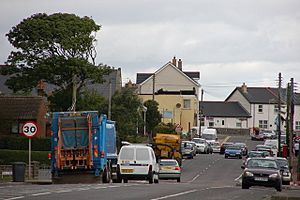Millisle facts for kids
Quick facts for kids Millisle
|
|
|---|---|
 Millisle Main Street, August 2006 |
|
| Population | 2,318 (2011 Census) |
| District |
|
| County | |
| Country | Northern Ireland |
| Sovereign state | United Kingdom |
| Post town | NEWTOWNARDS |
| Postcode district | BT22 |
| Dialling code | 028 |
| Police | Northern Ireland |
| Fire | Northern Ireland |
| Ambulance | Northern Ireland |
| EU Parliament | Northern Ireland |
| UK Parliament |
|
Millisle or Mill Isle is a small village in County Down, Northern Ireland. It is located on the Ards Peninsula. The name comes from the Scots words mill and isle. This means "the meadow of the mill."
Millisle is about 3 kilometers (2 miles) south of Donaghadee. In 2011, the village had a population of 2,318 people.
Contents
Understanding the Name Millisle
The name Millisle might come from an old Irish name. This name was Baile an Mhuilin. It means "Townland of the mill."
Another idea is that Scottish settlers brought the name. They might have named it after a place called Millisle in Scotland.
Millisle's Population Facts
In the 2011 Census, Millisle had 2,318 people. There were 991 households in the village.
The NI Statistics and Research Agency (NISRA) calls Millisle a village. This means its population is between 1,000 and 2,250 people.
Here are some facts from the 2001 Census:
- About 19% of the people were under 16 years old.
- About 25.5% of the people were 60 years or older.
- Almost 48% of the population were male.
- About 52% of the population were female.
- About 6% of people aged 16–74 were unemployed.
A Look at Millisle's History
Kindertransport and Refugee Farm
In 1939, many Jewish children came to the UK. This was part of the Kindertransport program. Some of these children came to Northern Ireland.
Many lived with foster families. Others stayed at the Millisle Refugee Farm. This farm was also known as "Magill's Farm." It helped refugees from May 1938 until it closed in 1948.
Millisle Airfield Project
In 1944, work began on Millisle Airfield. This airfield was meant for the USAAF (United States Army Air Forces). However, the ground was found to be unstable. Because of this, construction stopped. Today, only two concrete runways remain.
Cool Places to Visit in Millisle
- Ballycopeland Windmill: This is an old tower mill from the late 1700s. It was used until 1915. You can still see it working today! The visitor center has a model of the mill. It also has a restored kiln for drying corn.
- Millisle Lagoon and Beach Park: This park has a beach that is about 150 meters (165 yards) long. In 2010, it won a 'Seaside Award'. This award was given by the Northern Ireland Tourist Board. It recognized the beach's natural beauty and cleanliness.
- Northern Ireland Prison Service College: This college is located on the edge of Millisle. It covers an area of about 8.5 hectares (21 acres). This is where people train to become prison officers.
- The First and Last Pub: This pub is in Millisle. People say William III of England visited it in 1690. He was on his way to the Battle of the Boyne. However, the pub was actually built in 1790. This was 100 years after the battle!
- Lisnevin Training School: This building used to be a summer home for a family. Then it became a home for young offenders. It was also known as the Millisle Borstal. Later, it became a training center for prison officers. This center closed in 2003. The building was sold in 2018.
Sports in Millisle
Abbey Villa F.C. is a local football club. They play association football in the Northern Amateur Football League.
Famous People from Millisle
- Amy Carmichael (1867–1951): She was a Christian missionary. She worked in India. Amy Carmichael was born in Millisle. Her family home was taken down in 2002. A plaque was put up to remember the spot.
- William Kelly (1821–1906): He was a writer and scholar. He was an important member of the Plymouth Brethren. William Kelly was also born in Millisle.
See also
 In Spanish: Millisle para niños
In Spanish: Millisle para niños



